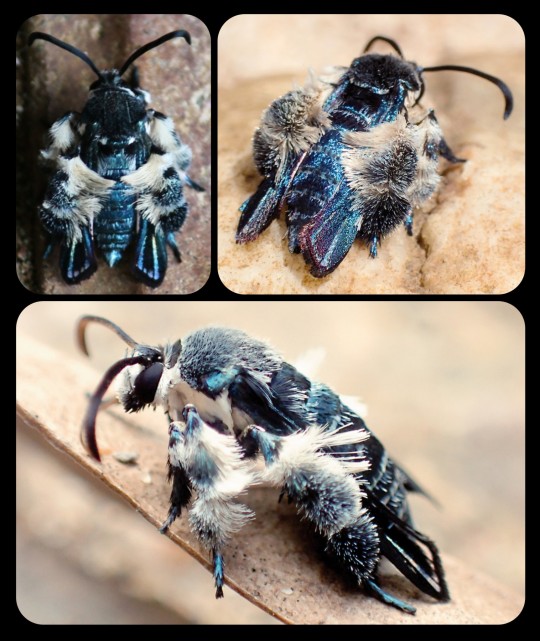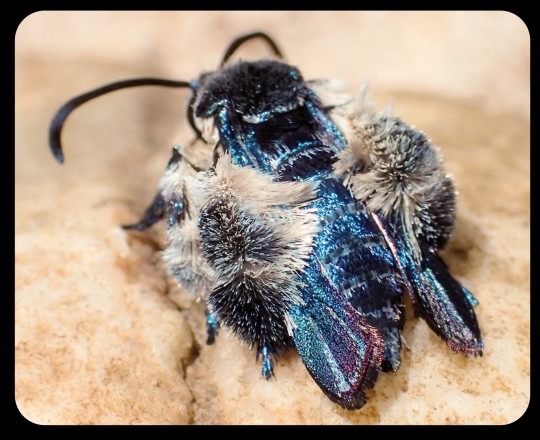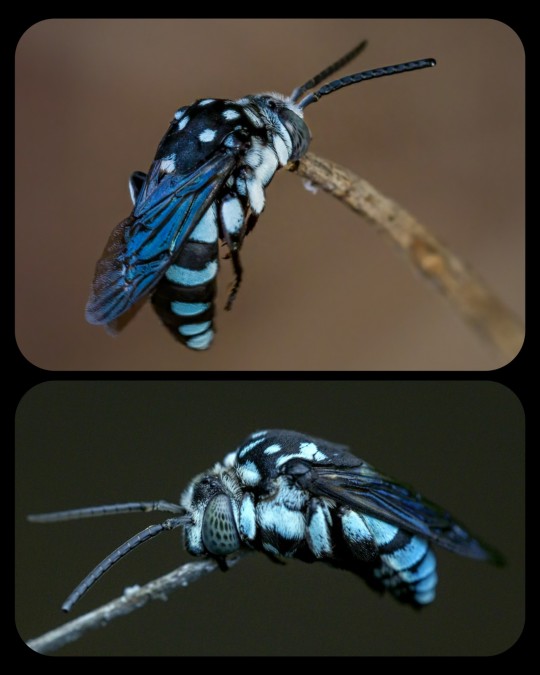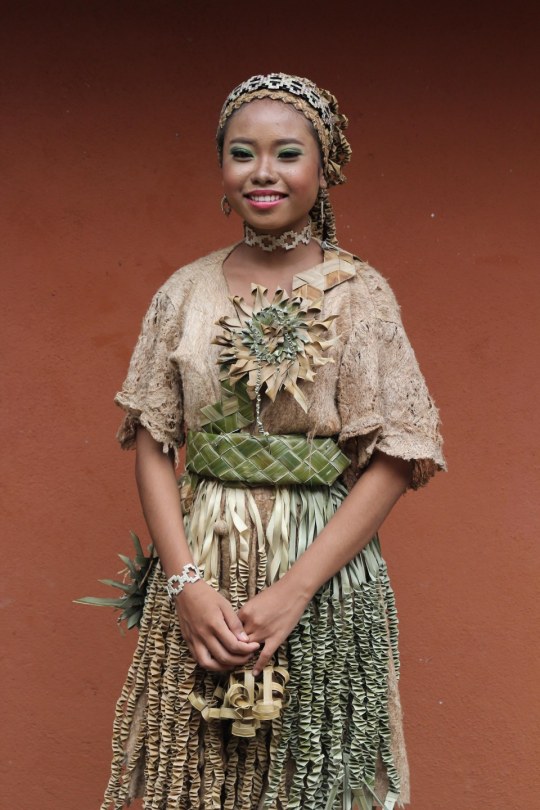#Malaysia (Asia)
Explore tagged Tumblr posts
Text
The Oriental Blue Clearwing Moth: these moths were regarded as a "lost species" for more than 130 years, until they were finally sighted again in 2013

For more than 130 years, the Oriental blue clearwing moth (Heterosphecia tawonoides) was known only from a single, badly damaged specimen that was collected in Sumatra in 1887. There were no recorded sightings of this species again until 2013, when entomologist Dr. Marta Skowron Volponi unexpectedly found the moths feeding on salt deposits that had accumulated along the riverbanks in Malaysia's lowland rainforest.

These moths were observed by researchers again in 2016 and 2017, and research indicates that the moths are actually bee-mimics, as they mimic the appearance, sound, behavior, and flight patterns of local bees. Their fuzzy, bright blue appearance might seem a little out of place for a bee-mimic, but those features do appear in several different bee species throughout Southeast Asia.
When the moths are in flight, they bear a particularly strong resemblance to the bees of the genus Thyreus (i.e. cuckoo bees, otherwise known as cloak-and-dagger bees), several of which are also bright blue, with banded markings, dark blue wings, fuzzy legs, and smooth, rounded antennae. The physical resemblance is compounded by the acoustic and behavioral mimicry that occurs when the moths are in flight.

Cloak-and-Dagger Bees: the image at the top shows an Indo-Malayan cloak-and-dagger bee (Thyreus novaehollandiae) in a sleeping position, holding itself upright with its mandibles clamped onto a twig, while the image at the bottom shows a Himalayan cloak-and-dagger bee (T. himalayensis) resting in the same position
The moths also engage in "mud-puddling" among the various bees that congregate along the riverbanks; mud-puddling is the process whereby an insect (usually a bee or a butterfly) draws nutrients from the fluids found in puddles, wet sand, decaying plant matter, carrion, animal waste, sweat, tears, and/or blood. According to researchers, the Oriental blue clearwing moth was the only lepidopteran that was seen mud-puddling among the local bees.
Dr. Skowron Volponi commented on the unusual appearance and behavior of these moths:
You think about moths and you envision a grey, hairy insect that is attracted to light. But this species is dramatically different—it is beautiful, shiny blue in sunlight and it comes out during the day; and it is a master of disguise, mimicking bees on multiple levels and even hanging out with them. The Oriental blue clearwing is just two centimeters in size, but there are so many fascinating things about them and so much more we hope to learn.
This species is still incredibly vulnerable, as it faces threats like deforestation, pollution, and climate change. The president of Global Wildlife Conservation, which is an organization that seeks to rediscover "lost species," added:
After learning about this incredible rediscovery, we hope that tourists visiting Taman Negara National Park and picnicking on the riverbanks—the home of these beautiful clearwing moths—will remember to tread lightly and to take their trash out of the park with them. We also recommend that Americans learn about palm oil production, which is one of the primary causes of deforestation in Malaysia.
Sources & More Info:
Phys.org: Bee-Mimicking Clearwing Moth Buzzes Back to Life After 130 Years
Mongabay News: Moth Rediscovered in Malaysia Mimics Appearance and Behavior of Bees to Escape Predators
Journal of Tropical Conservation Science: Lost Species of Bee-Mimicking Clearwing Moth, H. tawonoides, Rediscovered in Peninsular Malaysia's Primary Rainforest
Frontiers in Zoology: Southeast Asian Clearwing Moths Buzz like their Model Bees
Royal Society Publishing: Moving like a Model - mimicry of hymenopteran flight trajectories by clearwing moths of Southeast Asian rainforests
Medium: Rediscovery in a Glint of Blue
re:wild.org: The "Search for Lost Species" Project
#lepidoptera#moths#heterosphecia tawonoides#oriental blue clearwing moth#entomology#insects#cute bugs#nature#animals#lost species#mimicry#evolution#bees#southeast asia#Malaysia#colorful moths#bee mimic#science
1K notes
·
View notes
Text

Bornean bearded pig Sus barbatus barbatus
Observed by galewski, CC BY-NC
446 notes
·
View notes
Text

Mah Meri girl, Malaysia, by Barcroft Media
#mah meri#malaysia#asia#southeast asia#folk clothing#traditional clothing#traditional fashion#cultural clothing
719 notes
·
View notes
Text

A basal trapdoor spider (Liphistius desultor) poises at the entrance of its den in Penang, Malaysia
by Roy Kittrell
#basal trapdoor spiders#trapdoor spiders#spiders#arachnids#liphistius desultor#liphistius#Liphistiidae#Araneae#arachnida#arthropoda#wildlife: malaysia#wildlife: asia
236 notes
·
View notes
Text
Magunatip Bamboo Dance, Sabah, Malaysia: Magunatip, which is also known as “Bamboo Dance”, is one of the most popular traditional dances of Sabah. This energetic dance is performed by Murut people, who mainly reside in the interior districts of Sabah… The Murut constitute an indigenous ethnic community comprising 29 distinct sub-ethnic groups dwelling within the northern inland territories of Borneo. Wikipedia
#Magunatip Bamboo Dance#Sabah#Kwijau indigenous ethnic group#Eastern Malaysia#Island of Borneo#Malaysia#Asia#Asian Continent
187 notes
·
View notes
Text
In the estate, Thangamaal, despite not knowing how to read or write, raised her son, Neelavanan, with stories from the Mahabaratham, Ramayanam, as well as Tamil Bhakti songs. In spite of her devotion towards Hinduism, she was a woman who liked eating beef, a meat often seen as ‘impure’ by caste-Hindus.
“Once, my mother bought beef from the town, and when the neighbours asked her what she was cooking, she said mutton. When I asked my akka (sister) why amma (mother) said that, she told me that people [Hindus] who pray can’t eat beef,” recalled Neelavanan.
As Neelavanan grew up, he understood that Hindu religiosity surrounding beef was a weapon against Dalits who consume it. “People around me eat mutton, chicken, water monitors, pork—they eat everything,” he said. “But when it comes to beef, they say that it is god. They brand [Hindus] who eat beef as coming from a certain caste. We are buying [beef] with our own money; we did not steal or beg for it. Yes, I eat beef, so what?”
Ove time, however, the culture of eating beef has deliberately declined among Dalits in Malaysia as a way to escape casteism and adapt to caste-Hindu practices. This shift can be seen in Neelavanan’s own family, where his siblings and relatives refuse to eat beef and even scrutinise him for his beef-eating habits.
182 notes
·
View notes
Text
PLEASE PLEASE PLEASE WATCH THIS!!! ESPECIALLY IF YOU'RE ASIAN OR YOUR COUNTRY HAS BEEN COLONIZED!!!!
#asian#korea#philippines#singapore#china#japan#indonesia#malaysia#thailand#asia#india#nepal#palestine#free palestine#colonization
430 notes
·
View notes
Text

Kuala Lumpur, Malaysia
127 notes
·
View notes
Text

PETRONAS TWIN TOWERS - KUALA LUMPUR
118 notes
·
View notes
Text

#Philippines saying god bless.. His Catholic ass#hetalia#hetalia world stars#hetalia world series#hetalia world twinkle#aph philippines#hws philippines#hetalia philippines#aph indonesia#hws indonesia#hetalia indonesia#Aph Malaysia#Hws Malaysia#Hetalia Malaysia#Hws ASEAN#Aph ASEAN#Aph South East Asia#Hws South East Asia#Hetalia South East Asia#Aph Asia#Hws Asia#Hetalia Asia#Hetalia memes#Hetalia shitpost#Hetalia meme#I was told that the last image is what a lot of hispanic moms send on whatsapp and shit LMAOOO HELP
411 notes
·
View notes
Text

Batu Caves, Selangor, Malaysia | by Real Mint
371 notes
·
View notes
Photo

Penang, Malaysia
#penang#malaysia#around the world#asia#country#island#travel#tourism#travel blog#travel photography#uploads#nature#nature photography#nature blog
642 notes
·
View notes
Text

Malayan tapir Tapirus indicus
Observed by jsclough, CC BY-NC
110 notes
·
View notes
Text

Iban man, Malaysia, by jeffzzz11
#iban#malaysia#asia#southeast asia#folk clothing#traditional clothing#traditional fashion#cultural clothing
371 notes
·
View notes
Text

A female trilobite beetle (Platerodrilus sp.) in Malaysia
by Anthony KeiC Wong
#trilobite beetle#beetles#platerodrilus#lycidae#coleoptera#insecta#arthropoda#wildlife: malaysia#wildlife: asia
636 notes
·
View notes
Text





“施比受更有福” Kuala Lumpur, 2023
#kuala lumpur#malaysia#southeast asia#film photography#photography#streets#lanterns#featuring a truly impressive banyan tree#吉隆坡
101 notes
·
View notes